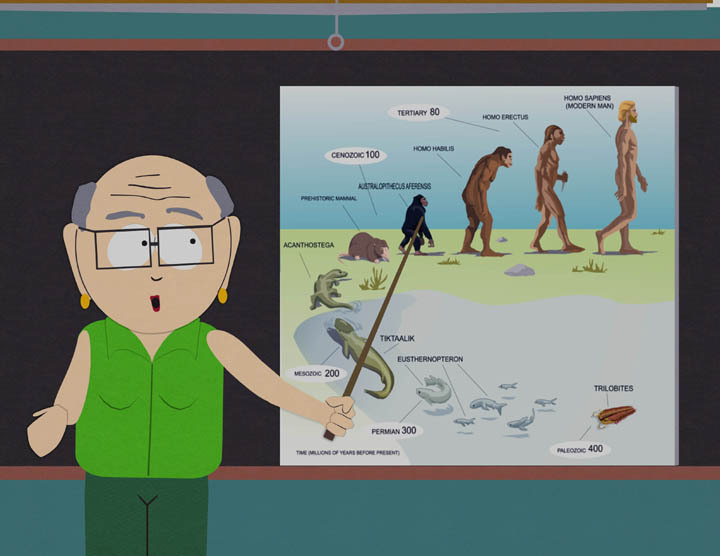Sex on the beach?
 Mr Garrison taught South Park Elementary children (season 10, episode 12) the good old fashion way of seeing evolution; “we are the retarded children of some retarded frog-fish-squirrel…”. This is the gradualist way of seeing evolutionary processes; leading from uninteresting jelly fishes to the mighty Arnold Shwarzenegger.
Mr Garrison taught South Park Elementary children (season 10, episode 12) the good old fashion way of seeing evolution; “we are the retarded children of some retarded frog-fish-squirrel…”. This is the gradualist way of seeing evolutionary processes; leading from uninteresting jelly fishes to the mighty Arnold Shwarzenegger.
Many scientists reject this gradualist view in favour of Darwin’s idea that “there is no innate tendency leading to progress in evolution”. But do they really gave up this idea? A few gradualistic events in the history of life remains firmly accepted such as how the vertebrates went out of the water. This theory refers to fossil evidence from the Late Devonian period (that’s about 350 million years ago), suggesting that early tetrapods used their legs to go out of the water and conquer the brave new terrestrial world.
However, during this last decade, many paleontologists (yes, they don’t just look for dinos) pointed out some disturbing facts: the early tetrapods, such as the iconic Ichthyostega, were in fact not able to walk out of the water at all! So why the hell did they develop legs?
This question is an example of my favourite part of macroevolution: exaptations (when the function of a trait shifts during evolution). The French palaeontologist, S. Steyer, pointed out that early legs may have been used in many way before being useful to Usain Bolt: for swimming, for hunting (used to hold onto the seabed) or even… for sex! S. Steyer suggested that legs could have been used to grab the female during sexy time as frogs do today.
Other interesting aspects of this gradual transition from water to land are the timing and the possible reasons why early tetrapods left the water to go conquer the new terrestrial world – which was not new at all by the way; arthropods had ventured out of the water since the early Devonian. Recent tracks discovered in Poland suggest that a 50cm long “retarded fish-frog” walked on the beach in the Early-Middle Devonian, that’s 20 million years before Mr. Ichthyostega was groping his lovely wife. Niedzwiedzki and his team interpreted these tracks (and some other “younger” ones like the Irish Valentia Island trackway) as belonging to some tetrapods that eventually went out of the sea to scavenge on the beach on low tide.
So was there really a graduale evolution from water to land in vertebrates? Who really made these tracks if it wasn’t Ichthyostega who actually just “walked” like a walrus? Even though legs probably didn’t evolve for walking, some tetrapods may have thought that it would be fun to go on the beach for a walk and get yummy carcasses. Were their other tetrapod colleagues using their legs for less adventurous but still cool purposes such as the possibilities listed above? As an answer to these questions, let’s just say that it’s complicated and it takes more than one big step on the shore to go from the “retarded fish-frogs”…
Photo credit: South Park – season 10, episode 12
